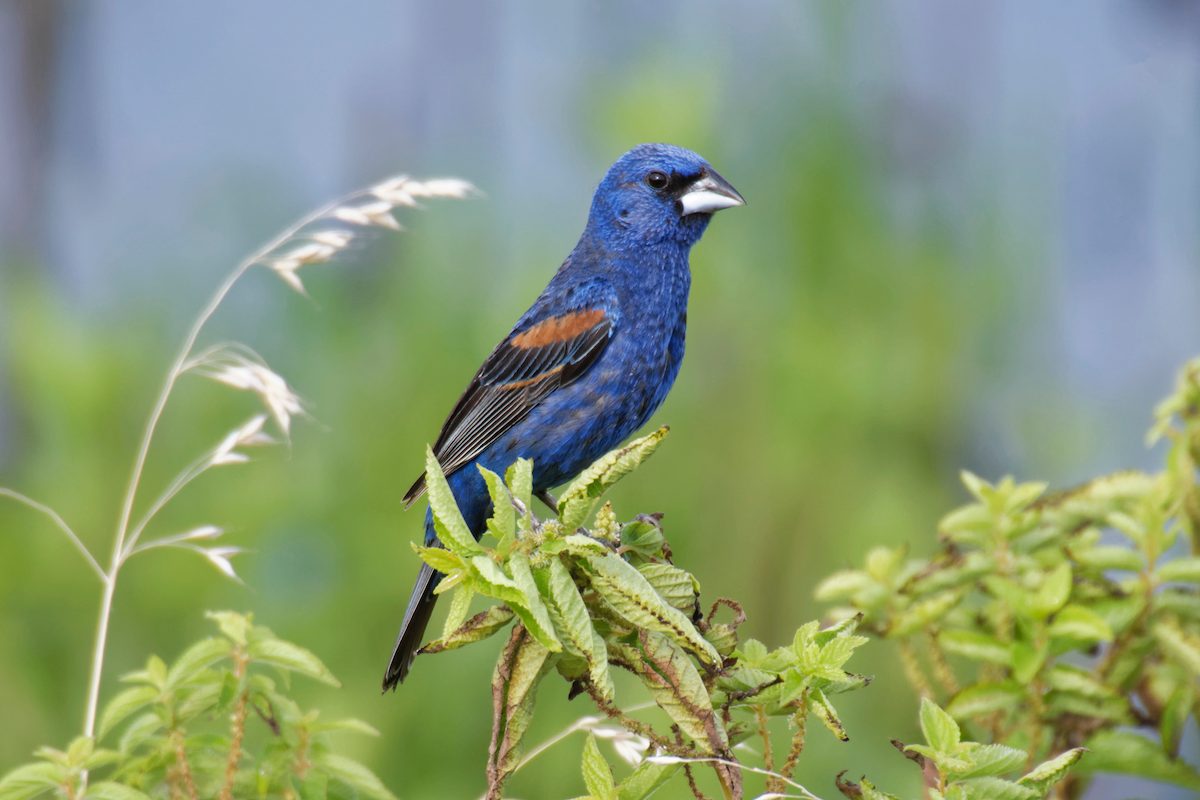Learn about the beautiful, but uncommon, blue grosbeak, including the bird's range map, diet, nesting habits, song and more.

Get to Know the Gorgeous Blue Grosbeak

On This Page
What Does a Blue Grosbeak Look Like?

Any sighting of a blue grosbeak is a cause for celebration, because these beautiful birds just aren’t that common and they can be difficult to attract.
Cinnamon to chestnut brown wing bars are a feature for blue grosbeaks. Males are vibrant blue, while females and immature males have rich brown heads and show hints of blue along the backs, wings and tails. Watch for blue grosbeaks to twitch their tails sideways.
These blue birds are sometimes mistaken for indigo buntings, another blue Neotropical migrant that arrives at feeders in spring. Warm brown wingbars and a huge bill are what set blue grosbeaks apart.

“Grosbeak,” from the French grosbec, means “large beak,” and, boy, does this bird ever have one! The massive bill is dark on top, with a lower mandible of eye-catching silver. However, blue grosbeaks are more closely related to lazuli buntings than they are to other grosbeaks.
Learn more about the types of grosbeaks backyard birders should know.
Range and Habitat

Blue grosbeaks are among the last species to return north and set up breeding territories.
Although their nesting range covers most of the lower half of the country, spotting one is a rare treat. Look for them in the brush along roadsides and in old fields. “Most people see them only fleetingly during spring migration,” says Bubba Scales, who formerly owned a Wild Birds Unlimited franchise store in Gainesville, Florida. Your best bet may be a migratory hotspot.
During fall migration, blue grosbeaks tend to fly straight south. In the West, they stick to overland routes arriving in Mexico, but eastern birds cross the Gulf of Mexico and island-hop to wintering grounds in the Caribbean.
Population Numbers
No one knows why these beautiful birds aren’t more abundant. In 1834, John James Audubon wrote in The Birds of America, “Although this sweet songster spends the spring and summer in our southern states, it must be considered as a rather scarce bird there.”
In fact, the Cornell Lab of Ornithology reports that the blue grosbeak is so scarce that virtually all aspects of its biology are poorly known. But unlike some bird species, blue grosbeaks did not experience a decline in population in the last 50 years. There may be even more of these birds around today. So next time you see a blue grosbeak, savor the moment!
Learn how to attract rose-breasted grosbeaks.
Blue Grosbeak Nests

During the breeding season, they aren’t backyard birds—unless your backyard includes acres of the shrub-dotted field habitat this species seeks. Bubba, a self-described bird nerd, has feeders on his 10-acre property where he enjoys filming the birds. “Blue grosbeaks visited this feeder every day for four months!” he says.
Nesting season lasts all summer because they often raise two broods. The small nest, often utilizing snakeskins, is built just a few feet off the ground in a bush, briar patch or tangle of vines. Up to five nestlings may cozy up in the little cup.
Cowbirds parasitize blue grosbeak nests, but researchers report the parents still manage to raise at least one nestling of their own, despite the interloper.
Learn how to identify an evening grosbeak.
Blue Grosbeak Song
Look for male birds singing their musical warbles from utility wires or the tops of small trees.
Bird sounds courtesy of the Cornell Lab of Ornithology
What Does a Blue Grosbeak Eat?

Blue grosbeaks may visit backyards anywhere within their range during migration. If a blue grosbeak does grace your feeder, take Bubba’s advice and serve its favorite food. “No. 1 is sunflower seed chips!” he says, along with whole sunflower seeds and millet. Then enjoy the visit of this uncommon bird for as long as it stays.
Meaty grasshoppers make up the biggest part of this grosbeak’s diet, bolstered by other large insects (such as the praying mantis) and seeds, which are plentiful near the nesting sites. Still, often only a single pair of grosbeaks lays claim to a large field.
Next, learn more about black-headed grosbeaks and pine grosbeaks.
Sources
- All About Birds – blue grosbeak
- Sibley Field Guide to Birds of Eastern North America
- National Audubon Society – blue grosbeak
- A.C. Bent series, Life Histories of North American Cardinals, Grosbeaks, Buntings, Towhees, Finches, Sparrows, and Allies, Part 1
- Birds of the World – blue grosbeak
About the Expert
Bubba Scales is the former owner of a Wild Birds Unlimited store in Gainesville, Florida, which he operated with his wife, Ingrid. He has a master’s degree in coastal research management from Duke University’s Nicholas School of the Environment.






















